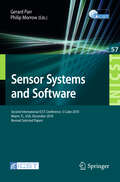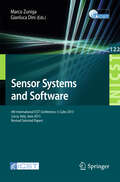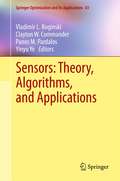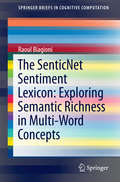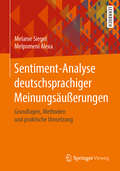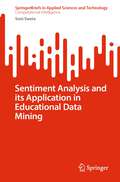- Table View
- List View
Sensor Systems and Software: 13th EAI International Conference, S-Cube 2022, Dalian, China, December 7-9, 2022, Proceedings (Lecture Notes of the Institute for Computer Sciences, Social Informatics and Telecommunications Engineering #487)
by Hamid Reza Karimi Ning WangThis book constitutes the proceedings of the 13th International Conference on Sensor Systems and Software, S-Cube 2022, which was held in Dalian, China, in December 7-9, 2022. The 16 revised full papers in this book were selected from 42 submissions and are organized in three thematic sessions on sensor technology for marine systems; resilience control systems; and applications.
Sensor Systems and Software: 7th International Conference, S-Cube 2016, Sophia Antipolis, Nice, France, December 1-2, 2016, Revised Selected Papers (Lecture Notes of the Institute for Computer Sciences, Social Informatics and Telecommunications Engineering #205)
by Michele Magno Fabien Ferrero Vedran BilasThis book constitutes the thoroughly refereed post-conference proceedings of the 7th EAI International Conference on Sensor Systems and Software, S-Cube 2016, held in Sophia Antipolis, Nice, France, in December 2016. The 15 revised full papers and 5 invited papers cover technologies for wireless sensor networks, smart city and industry 4.0 applications, and smart sensing.
Sensor Systems and Software: Third International ICST Conference, S-Cube 2012, Lisbon, Portugal, June 4-5, 2012, Revised Selected Papers (Lecture Notes of the Institute for Computer Sciences, Social Informatics and Telecommunications Engineering #102)
by Francisco Martins Luís Lopes Hervé PaulinoThis book constitutes the thoroughly refereed post-conference proceedings of the Third International ICST Conference on Sensor Systems and Software, S-Cube 2012, held in Lisbon, Portugal in June 2012. The 12 revised full papers presented were carefully reviewed and selected from over 18 submissions and four invited talks and cover a wide range of topics including middleware, frameworks, learning from sensor data streams, stock management, e-health, and Web Of Things.
Sensor Systems and Software: Second International ICST Conference, S-Cube 2010, Miami, FL, December 13-15, 2010, Revised Selected Papers (Lecture Notes of the Institute for Computer Sciences, Social Informatics and Telecommunications Engineering #57)
by Gerard Parr Philip MorrowThis book constitutes the thoroughly refereed post-conference proceedings of the Second International ICST Conference on Sensor Systems and Software, S-Cube 2010, held in Miami, Florida, USA, in December 2010. The 17 revised full papers presented were carefully reviewed and selected and cover a wide range of topics including sensor application programming paradigms, novel sensor applications, sensor network middleware, trust security and privacy, wireless sensor network management and monitoring, and sensor application development support systems.
Sensor Systems and Software: 4th International ICST Conference, S-Cube 2013, Lucca, Italy, June 11-12, 2013, Revised Selected Papers (Lecture Notes of the Institute for Computer Sciences, Social Informatics and Telecommunications Engineering #122)
by Marco Zuniga Gianluca DiniThis book constitutes the thoroughly refereed post-conference proceedings of the 4th International ICST Conference on Sensor Systems and Software, S-Cube 2013, held in Lucca, Italy, 2013. The 8 revised full papers and 2 invited papers presented cover contributions on different technologies for wireless sensor networks, including security protocols, middleware, analysis tools and frameworks.
Sensor Technologies: Healthcare, Wellness and Environmental Applications
by Michael J. McGrath Cliodhna Ni Scanaill Dawn NafusSensor Technologies: Healthcare, Wellness and Environmental Applications explores the key aspects of sensor technologies, covering wired, wireless, and discrete sensors for the specific application domains of healthcare, wellness and environmental sensing. It discusses the social, regulatory, and design considerations specific to these domains. The book provides an application-based approach using real-world examples to illustrate the application of sensor technologies in a practical and experiential manner. The book guides the reader from the formulation of the research question, through the design and validation process, to the deployment and management phase of sensor applications. The processes and examples used in the book are primarily based on research carried out by Intel or joint academic research programs. “Sensor Technologies: Healthcare, Wellness and Environmental Applications provides an extensive overview of sensing technologies and their applications in healthcare, wellness, and environmental monitoring. From sensor hardware to system applications and case studies, this book gives readers an in-depth understanding of the technologies and how they can be applied. I would highly recommend it to students or researchers who are interested in wireless sensing technologies and the associated applications.” Dr. Benny Lo Lecturer, The Hamlyn Centre, Imperial College of London “This timely addition to the literature on sensors covers the broad complexity of sensing, sensor types, and the vast range of existing and emerging applications in a very clearly written and accessible manner. It is particularly good at capturing the exciting possibilities that will occur as sensor networks merge with cloud-based ‘big data’ analytics to provide a host of new applications that will impact directly on the individual in ways we cannot fully predict at present. It really brings this home through the use of carefully chosen case studies that bring the overwhelming concept of 'big data' down to the personal level of individual life and health.” Dermot Diamond Director, National Centre for Sensor Research, Principal Investigator, CLARITY Centre for Sensor Web Technologies, Dublin City University "Sensor Technologies: Healthcare, Wellness and Environmental Applications takes the reader on an end-to-end journey of sensor technologies, covering the fundamentals from an engineering perspective, introducing how the data gleaned can be both processed and visualized, in addition to offering exemplar case studies in a number of application domains. It is a must-read for those studying any undergraduate course that involves sensor technologies. It also provides a thorough foundation for those involved in the research and development of applied sensor systems. I highly recommend it to any engineer who wishes to broaden their knowledge in this area!" Chris Nugent Professor of Biomedical Engineering, University of Ulster
Sensorimotor Integration in the Whisker System
by Patrik Krieger Alexander GrohSensorimotor integration, the dynamic process by which the sensory and motor systems communicate with each other, is crucial to humans’ and animals’ ability to explore and react to their environment. This book summarizes the main aspects of our current understanding of sensorimotor integration in 10 chapters written by leading scientists in this active and ever-growing field. This volume focuses on the whisker system, which is an exquisite model to experimentally approach sensorimotor integration in the mammalian brain.In this book, authors examine the whisker system on many different levels, ranging from the building blocks and neuronal circuits to sensorimotor behavior. Neuronal coding strategies, comparative analysis as well as robotics illustrate the multiple facets of this research and its broad impact on fundamental questions about the neurobiology of the mammalian brain.
Sensors: Advancements in Modeling, Design Issues, Fabrication and Practical Applications (Lecture Notes in Electrical Engineering #21)
by Yueh-Min Ray HuangSensors are the most important component in any system and engineers in any field need to understand the fundamentals of how these components work, how to select them properly and how to integrate them into an overall system. This book has outlined the fundamentals, analytical concepts, modelling and design issues, technical details and practical applications of different types of sensors, electromagnetic, capacitive, ultrasonic, vision, Terahertz, displacement, fibre-optic and so on. The book: addresses the identification, modeling, selection, operation and integration of a wide variety of sensors, demonstrates the concepts of different sensors technology through simulation, design and real implementations, discusses the design and fabrication of high performance modern sensors technology, presents a selection of cutting-edge applications. Written by experts in their area of research, this book will be useful reference book for engineers and scientist especially the post-graduate students find this book as reference book for their research.
Sensors: Theory, Algorithms, And Applications (Springer Optimization and Its Applications #61)
by Vladimir L. Boginski, Clayton W. Commander, Panos M. Pardalos and Yinyu YeThe objective of this book is to advance the current knowledge of sensor research particularly highlighting recent advances, current work, and future needs. The goal is to share current technologies and steer future efforts in directions that will benefit the majority of researchers and practitioners working in this broad field of study.
Sensors and Protocols for Industry 4.0: Industrial Applications of Maker Tech (Maker Innovations Series)
by G. R. Kanagachidambaresan Bharathi NThis book Identifies the right sensors and single board computers for any application to achieve the best performance in Industry 4.0 settings and applications. You’ll see what technologies apply the IIoT with elegant efficiency to drastically improve remote monitoring and controlling, decision making, and preventative maintenance. Start by learning exactly what Industry 4.0 is and advance your knowledge from simple Internet of Things projects to full-on Industrial IoT deployment. You'll automate advanced processes, incorporate professional procedures, and take your IoT skills to a professional level. Then move into the protocols and standards expected for industrial applications of sensors at an industrial level. Match the right SBCs to the right use cases and sensor technologies to optimize efficiency and ensure peak performance. Then move into setting up a smart factory and monitoring your supply chain with tech. Finally, you'll dive into programming with the Node-Red platform and Python packages for CPS. By the end of this book, you’ll have jumped from simple, home-based IoT systems up to industrial and professional applications. Conquer your supply chain and both forward and backward processes with accessible Maker tech! What You'll Learn Support industrial applications of SBCs and Maker tech Achieve peak performance by combining the right sensors with the right processing boards Improve remote monitoring and controlling drastically for better decision making and preventative maintenance Who This Book Is For Students and aspiring professionals working with Internet of things technologies moving towards industrial applications. Prerequisite knowledge in basic Internet of Things, simple python concepts, automation, and industry procedures is required for this book. Engineers and scientists who are pursuing research and contributing to industrial internet of things might also benefit.
Sensors and Sensory Systems for Advanced Robots (NATO ASI Subseries F: #43)
by Paolo Dario Centro E. PiaggioThis volume contains papers presented at the NATO Advanced Research Workshop (ARW) on "Sensors and Sensory Systems for Advanced Robots", which was held in Maratea, Italy, during the week Apri I 28 - May 3, 1986. Participants in the ARW, who came from eleven NATO and two non-NATO countries, represented an i nternat i ona I assortment of d i st i ngu i shed research centers in industry, government and academia. Purpose of the Workshop was to rev i ew the state of the art of sensing for advanced robots, to discuss basic concepts and new ideas on the use of sensors for robot control and to provide recommendations for future research in this area, There IS an almost unanimous consensus among invest i gators in the fie I d of robot i cs that the add i t i on of sensory capabi I ities represents the "natural" evolution of present industrial robots, as wei I as the necessary premise to the development of advanced robots for nonindustrial app I i cat ions. However, a number of conceptua I and techn i ca I problems sti I I challenge the practical implementation and widespread appl ication of sensor-based robot control techn i ques. Cruc i a I among those prob I ems is the ava i lab iii ty of adequate sensors.
Sensors, Cloud, and Fog: The Enabling Technologies for the Internet of Things
by Sudip Misra Subhadeep Sarkar Subarna ChatterjeeThis book provides an in-depth understanding of Internet of Things (IoT) technology. It highlights several of today's research and technological challenges of translating the concept of the IoT into a practical, technologically feasible, and business-viable solution. It introduces two novel technologies--sensor-cloud and fog computing--as the crucial enablers for the sensing and compute backbone of the IoT. The book discusses these two key enabling technologies of IoT that include a wide range of practical design issues and the futuristic possibilities and directions involving sensor networks and cloud and fog computing environments towards the realization and support of IoT. Classroom presentations and solutions to end of chapter questions are available to instructors who use the book in their classes.
Sensors, Cloud, and Fog: The Enabling Technologies for the Internet of Things
by Sudip Misra Subhadeep Sarkar Subarna ChatterjeeThis book provides an in-depth understanding of Internet of Things (IoT) technology. It highlights several of today's research and technological challenges of translating the concept of the IoT into a practical, technologically feasible, and business-viable solution. It introduces two novel technologies--sensor-cloud and fog computing--as the crucial enablers for the sensing and compute backbone of the IoT. The book discusses these two key enabling technologies of IoT that include a wide range of practical design issues and the futuristic possibilities and directions involving sensor networks and cloud and fog computing environments towards the realization and support of IoT. Classroom presentations and solutions to end of chapter questions are available to instructors who use the book in their classes.
Sensors for Mobile Robots
by H.R. EverettThe author compiles everything a student or experienced developmental engineer needs to know about the supporting technologies associated with the rapidly evolving field of robotics.From the table of contents: Design Considerations * Dead Reckoning * Odometry Sensors * Doppler and Inertial Navigation * Typical Mobility Configurations * Tactile and
The Sensory Accommodation Framework for Technology: Bridging Sensory Processing to Social Cognition (Synthesis Lectures on Technology and Health)
by LouAnne BoydThis book provides a thorough introduction to the many facets of designing technologies for autism, with a particular focus on optimizing visual attention frameworks. This book is designed to provide a detailed overview of several aspects of technology for autism. Each Chapter illustrates different parts of the Sensory Accommodation Framework and provides examples of relevant available technologies. The books first discusses a variety of skills that make up human development as well as a history of autism as a diagnosis and the birth of the neurodiversity movement. It goes on to detail individual types of therapy and how they interact with autism. The systems involved in sensory processing and their specific relation to autism are then explored, including through technologies that have addressed these areas and applications for designers. Readers will learn about designing sensory environments and sensory interactions, such as through virtual reality. This book places a needed emphasis on the hierarchy of information in technology development by exploring visual attention in neurodivergent conditions like autism, ADHD, and dyslexia. It also delves into the relationship between sensory perception and nonverbal communication, the bridge between sensory input and social behavior, and dynamic information. The discussion is rounded out with examinations of temporal processing as and multisensory integration as complicating factors that have existing technological solutions. Finally, the book closes with a summary of the sensory accommodation framework in respect to how each layer offers different user experience goals and specific mechanisms to promote those goals. Readers from a variety of research backgrounds will find this book informative and useful, while designers will learn essential skills for effectively designing autism technologies.
Sensory Robotics for the Handling of Limp Materials (NATO ASI Subseries F: #64)
by Paul M. TaylorLimp materials are used in many economically impo~tant industries such as garment manufacture, shoe manufacture, aerospace (composites) and automobiles (seats and trim). The use of sensors is essential for reliable robotic handling of these materials, which are often based on naturally occurring substances such as cotton and leather. The materials are limp and have non-homogeneous mechanical properties which are often impossible to predict accurately. The applications are very demanding for vision and tactile sensing and signal processing, adaptive control systems, planning and systems integration. This book comprises the collection of papers presented at the NATO Advanced Research Workshop on 'Sensory Robotics for the Handling of Limp Materials', held in October 1988 at II Ciocco, Tuscany, Italy. The aim of the workshop was to examine the state of the art and determine what research is needed to provide the theoretical and technological tools for the successful application of sensory robotics to the handling of limp materials. The meeting also acted as the first-ever forum for the interchange of knowledge between applications-driven researchers and those researching into the provision of fundamental tools. The participants were drawn from academia (20), industry (5), and other non-university research organisations (5).
Sentic Computing: A Common-Sense-Based Framework for Concept-Level Sentiment Analysis (Socio-Affective Computing #1)
by Erik Cambria Amir HussainThis volume presents a knowledge-based approach to concept-level sentiment analysis at the crossroads between affective computing, information extraction, and common-sense computing, which exploits both computer and social sciences to better interpret and process information on the Web. Concept-level sentiment analysis goes beyond a mere word-level analysis of text in order to enable a more efficient passage from (unstructured) textual information to (structured) machine-processable data, in potentially any domain. Readers will discover the following key novelties, that make this approach so unique and avant-garde, being reviewed and discussed:• Sentic Computing's multi-disciplinary approach to sentiment analysis-evidenced by the concomitant use of AI, linguistics and psychology for knowledge representation and inference• Sentic Computing’s shift from syntax to semantics-enabled by the adoption of the bag-of-concepts model instead of simply counting word co-occurrence frequencies in text• Sentic Computing's shift from statistics to linguistics-implemented by allowing sentiments to flow from concept to concept based on the dependency relation between clausesThis volume is the first in the Series Socio-Affective Computing edited by Dr Amir Hussain and Dr Erik Cambria and will be of interest to researchers in the fields of socially intelligent, affective and multimodal human-machine interaction and systems.
Sentic Computing: Techniques, Tools, and Applications (SpringerBriefs in Cognitive Computation #2)
by Erik Cambria Amir HussainIn this book common sense computing techniques are further developed and applied to bridge the semantic gap between word-level natural language data and the concept-level opinions conveyed by these. In particular, the ensemble application of graph mining and multi-dimensionality reduction techniques is exploited on two common sense knowledge bases to develop a novel intelligent engine for open-domain opinion mining and sentiment analysis. The proposed approach, termed sentic computing, performs a clause-level semantic analysis of text, which allows the inference of both the conceptual and emotional information associated with natural language opinions and, hence, a more efficient passage from (unstructured) textual information to (structured) machine-processable data.
The SenticNet Sentiment Lexicon: Exploring Semantic Richness in Multi-Word Concepts (SpringerBriefs in Cognitive Computation #4)
by Raoul BiagioniThe research and its outcomes presented in this book, is about lexicon-based sentiment analysis. It uses single-, and multi-word concepts from the SenticNet sentiment lexicon as the source of sentiment information for the purpose of sentiment classification. In 6 chapters the book sheds light on the comparison of sentiment classification accuracy between single-word and multi-word concepts, for which a bespoke sentiment analysis system developed by the author was used. This book will be of interest to students, educators and researchers in the field of Sentic Computing.
Sentiment-Analyse deutschsprachiger Meinungsäußerungen: Grundlagen, Methoden und praktische Umsetzung
by Melanie Siegel Melpomeni AlexaDer Zugang zu Information ist durch das Internet erheblich verändert und erleichtert worden. Gleichzeitig gibt es seit dem Web 2.0 die Möglichkeit für alle Internet-Nutzer, selbst Inhalte beizusteuern, indem sie in Foren schreiben, oder Twitter, Xing, LinkedIn, Facebook oder andere soziale Medien nutzen und auf veröffentliche Posts z. B. durch Kommentare reagieren. Diese Fülle an Informationen und Meinungen ist ein wertvoller und in der Regel sehr großer Datenschatz, den man nur mit automatischen Verfahren sinnvoll nutzen kann.Die automatische Analyse von Meinungsäußerungen gehört in die Anwendungsbereiche Informationsextraktion und Inhaltsanalyse sowie Text Mining. Aus Texten von Internet-Nutzern werden Informationen extrahiert und analysiert, wie sie sich zu bestimmten Themen, Produkten oder Ereignissen äußern.Dieses Buch gibt eine systematische Einführung in Methoden der automatischen Analyse von Meinungsäußerungen und zeigt die Anwendung der beschriebenen Methoden in Programmierübungen. Der Fokus liegt dabei auf deutschsprachige Daten, also auf linguistischen Ressourcen sowie Methoden zur automatischen Analyse für die deutsche Sprache. Viele Übungsaufgaben sowie in Python implementierte Programmierbeispiele und -aufgaben machen das Buch zum optimalen Begleiter für Studium und Selbststudium.
Sentiment Analysis and Deep Learning: Proceedings of ICSADL 2022 (Advances in Intelligent Systems and Computing #1432)
by Subarna Shakya Ke-Lin Du Klimis NtalianisThis book gathers selected papers presented at International Conference on Sentimental Analysis and Deep Learning (ICSADL 2022), jointly organized by Tribhuvan University, Nepal and Prince of Songkla University, Thailand during 16 – 17 June, 2022. The volume discusses state-of-the-art research works on incorporating artificial intelligence models like deep learning techniques for intelligent sentiment analysis applications. Emotions and sentiments are emerging as the most important human factors to understand the prominent user-generated semantics and perceptions from the humongous volume of user-generated data. In this scenario, sentiment analysis emerges as a significant breakthrough technology, which can automatically analyze the human emotions in the data-driven applications. Sentiment analysis gains the ability to sense the existing voluminous unstructured data and delivers a real-time analysis to efficiently automate the business processes.
Sentiment Analysis and its Application in Educational Data Mining (SpringerBriefs in Applied Sciences and Technology)
by Soni SwetaThe book delves into the fundamental concepts of sentiment analysis, its techniques, and its practical applications in the context of educational data. The book begins by introducing the concept of sentiment analysis and its relevance in educational settings. It provides a thorough overview of the various techniques used for sentiment analysis, including natural language processing, machine learning, and deep learning algorithms. The subsequent chapters explore applications of sentiment analysis in educational data mining across multiple domains. The book illustrates how sentiment analysis can be employed to analyze student feedback and sentiment patterns, enabling educators to gain valuable insights into student engagement, motivation, and satisfaction. It also examines how sentiment analysis can be used to identify and address students' emotional states, such as stress, boredom, or confusion, leading to more personalized and effective interventions. Furthermore, the book explores the integration of sentiment analysis with other educational data mining techniques, such as clustering, classification, and predictive modeling. It showcases real-world case studies and examples that demonstrate how sentiment analysis can be combined with these approaches to improve educational decision-making, curriculum design, and adaptive learning systems.
Sentiment Analysis and Ontology Engineering: An Environment of Computational Intelligence (Studies in Computational Intelligence #639)
by Witold Pedrycz Shyi-Ming ChenThis edited volume provides the reader with a fully updated, in-depth treatise on the emerging principles, conceptual underpinnings, algorithms and practice of Computational Intelligence in the realization of concepts and implementation of models of sentiment analysis and ontology –oriented engineering. The volume involves studies devoted to key issues of sentiment analysis, sentiment models, and ontology engineering. The book is structured into three main parts. The first part offers a comprehensive and prudently structured exposure to the fundamentals of sentiment analysis and natural language processing. The second part consists of studies devoted to the concepts, methodologies, and algorithmic developments elaborating on fuzzy linguistic aggregation to emotion analysis, carrying out interpretability of computational sentiment models, emotion classification, sentiment-oriented information retrieval, a methodology of adaptive dynamics in knowledge acquisition. The third part includes a plethora of applications showing how sentiment analysis and ontologies becomes successfully applied to investment strategies, customer experience management, disaster relief, monitoring in social media, customer review rating prediction, and ontology learning. This book is aimed at a broad audience of researchers and practitioners. Readers involved in intelligent systems, data analysis, Internet engineering, Computational Intelligence, and knowledge-based systems will benefit from the exposure to the subject matter. The book may also serve as a highly useful reference material for graduate students and senior undergraduate students.
Sentiment Analysis and Opinion Mining (Synthesis Lectures on Human Language Technologies)
by Bing LiuSentiment analysis and opinion mining is the field of study that analyzes people's opinions, sentiments, evaluations, attitudes, and emotions from written language. It is one of the most active research areas in natural language processing and is also widely studied in data mining, Web mining, and text mining. In fact, this research has spread outside of computer science to the management sciences and social sciences due to its importance to business and society as a whole. The growing importance of sentiment analysis coincides with the growth of social media such as reviews, forum discussions, blogs, micro-blogs, Twitter, and social networks. For the first time in human history, we now have a huge volume of opinionated data recorded in digital form for analysis. Sentiment analysis systems are being applied in almost every business and social domain because opinions are central to almost all human activities and are key influencers of our behaviors. Our beliefs and perceptions of reality, and the choices we make, are largely conditioned on how others see and evaluate the world. For this reason, when we need to make a decision we often seek out the opinions of others. This is true not only for individuals but also for organizations. This book is a comprehensive introductory and survey text. It covers all important topics and the latest developments in the field with over 400 references. It is suitable for students, researchers and practitioners who are interested in social media analysis in general and sentiment analysis in particular. Lecturers can readily use it in class for courses on natural language processing, social media analysis, text mining, and data mining. Lecture slides are also available online. Table of Contents: Preface / Sentiment Analysis: A Fascinating Problem / The Problem of Sentiment Analysis / Document Sentiment Classification / Sentence Subjectivity and Sentiment Classification / Aspect-Based Sentiment Analysis / Sentiment Lexicon Generation / Opinion Summarization / Analysis of Comparative Opinions / Opinion Search and Retrieval / Opinion Spam Detection / Quality of Reviews / Concluding Remarks / Bibliography / Author Biography
Sentiment Analysis for PTSD Signals (SpringerBriefs in Computer Science)
by Vadim Kagan Edward Rossini Demetrios SapounasThis book describes a computational framework for real-time detection of psychological signals related to Post-Traumatic Stress Disorder (PTSD) in online text-based posts, including blogs and web forums. Further, it explores how emerging computational techniques such as sentiment mining can be used in real-time to identify posts that contain PTSD-related signals, flag those posts, and bring them to the attention of psychologists, thus providing an automated flag and referral capability. The use of sentiment extraction technologies allows automatic in-depth analysis of opinions and emotions expressed by individuals in their online posts. By training these automated systems with input from academic and clinical experts, the systems can be refined so that the accuracy of their detection of possible PTSD signals is comparable to that of psychologists reading the same online posts. While a portion of the literature on this and related topics explores the correlation between text patterns in archived documents and PTSD, no literature to date describes a system performing real-time analysis. Our system allows analysts to quickly identify, review, and validate online posts which have been flagged as exhibiting signs or symptoms of PTSD and enables follow-up, thus allowing for the presentation of treatment options to the authors of those posts. We describe the ontology of PTSD-related terms (i.e., terms which signal PTSD and related conditions) that need to be tracked, the algorithms used for extraction of the intensity of these signals, and the training process used to fine-tune sentiment analysis algorithms. We then present the results of processing a validation data set, different from the training set, comparing the algorithmic output with opinions of clinical psychologists, and explain how the concept can be extended to detect signals of other psychological conditions. We present a sample system architecture and implementation which can be used to engage users and their families, either anonymously or eponymously, and use the sentiment extraction algorithms as an early screening tool to alert clinicians to participants who may require close monitoring or follow-up. Finally, we describe a user test conducted with users recruited from the Veteran population and present the results of the analyses on the data.



